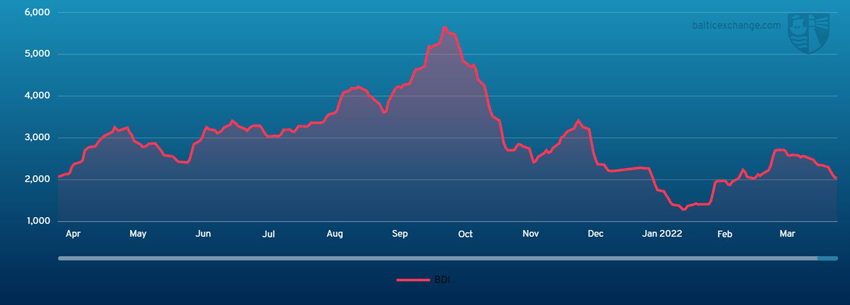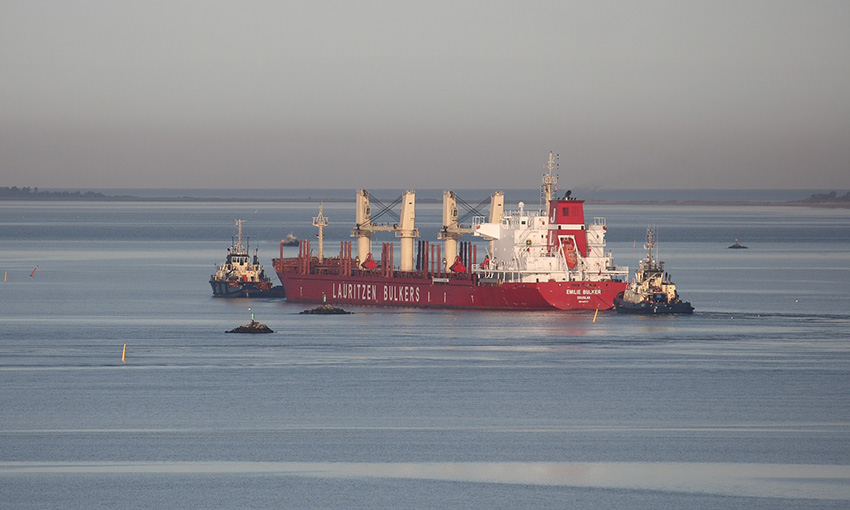LAST week, the Baltic Dry Index continued the moderate decline seen over several weeks. The index ended last week on 2055 (on 8 April) – this was a decrease of 13% on the previous Friday’s 2357.

Capesize
Overall it was not a very active week, with limited fresh cargo support from either of the basins. The BCI and timecharter average started the week at a level close to 1800 points and US$15,000 but remained in negative territory until a marginal improvement on Friday. The market settled at 1444 points and US$11,979, the lowest value since mid-February this year.
There was not much backhaul, fronthaul or trans-Atlantic cargo reported from the Atlantic this week. One of the main indicators, the C3 Brazil to Qingdao trade, declined over a dollar and is currently at US$24.775, reflecting a timecharter average of US$11,964 on the China-Brazil round voyage.
The C5 West Australia to Qingdao run climbed back to US$9.236 on Friday, marking the trans-Pacific round voyage at US$10,208 to close the week.
Panamax
A sluggish week activity wise for the Panamax market resulting in rates continuing to come under pressure. Noticeably the grain houses were absent from the market, which appeared to cause some anguish.
Activity in the Atlantic – and especially the trans-Atlantic trips – were disappointing overall. South America trans-Atlantic trips back to this side were seen fixed on tonnage open Continent/Mediterranean along with some ballaster tonnage. An 81,000-dwt delivery Morocco was seen fixing a trip via North Coast South America redelivery Far East at US$36,000 with fronthaul rates holding steady around this level on the week.
Asia returned a slow start with holidays impacting and failed to find any real traction. The NoPac round trips hovered around the US$20/21,000 mark for the majority, but with limited demand activity was slow. Period appetite was soft, underpinned by negative FFA and physical markets. However, an 82,000-dwt delivery India did achieve US$30,000 for four to six months trading.
Ultramax/Supramax
An uninspiring week in many areas as demand from China eased, leading to limited fresh enquiry and prompt tonnage availability growing in key areas such as South East Asia.
The Atlantic remained positional and rates eased slowly. Period activity was limited, but a 63,000-dwt open North China was heard fixed for four to six months trading at around US$33,000. From the Atlantic, steady demand from South America saw a 55,000-dwt fixing delivery Recalada trip to Nouakchott at US$37,500. Elsewhere, there was limited action from the Continent. A 56,000-dwt open Amsterdam fixed a trip to the East Mediterranean at US$27,250.
A fair amount of failing was seen from Asia, but a 56,000-dwt open Japan was fixed via South Korea redelivery Mediterranean at US$30,600. From the Indian Ocean a 63,000-dwt was fixed delivery South Africa trip to Pakistan at US$26,400 plus US$640,000 ballast bonus. The 10TC weighted average finished the week at US$27,518.
Handysize
It has been a turbulent week with most regions seeing declining levels due to various factors. In Asia there was limited activity party due to holidays in China. A 38,000-dwt open in South East Asia was rumoured to have been fixed for an Australian Round voyage at US$25,000 and a 38,0000-dwt open in Taicang was rumoured to have fixed a trip via East Coast Australia to China with an intended cargo of concentrates at US$27,500. The Continent saw more activity with a 38,000-dwt being fixed for four to six months with worldwide redelivery at US$26,000. The vessel was then being relet for her first let to carry a cargo of fertiliser from Murmansk to Brazil at US$38,000 as there is currently a premium for Russian loading cargoes. In the US Gulf a 39,000-dwt was rumoured to have been placed on subjects for a trip from Panama City to the UK with wood pellets at US$28,000.
Clean
The Middle East Gulf LRs have been subject to lesser demand again this week. The LR2s of TC1 75k Middle East Gulf/Japan have dropped again and are currently pegged at WS130. The LR1s also dropped, TC5 55k Middle East Gulf/Japan is currently heading towards WS150 and a trip west (TC8) also down to the US$2.5m – US$2.6m level. The MRs of TC17 35kt Middle East Gulf/East Africa have been active and freight has hopped up 21.9 points to WS304.17 for the moment. West of Suez, on the LR2s, TC15 80k Mediterranean/Japan has been retested down again this week and a widely reported fixture at US$2.5m looks to have led the index down to this level. The LR1s of TC16 60k Amsterdam/Offshore Lomé, have rebounded and hit WS140 this week. On the UK-Continent, MRs have been stable and TC2 has been hovering around the high 180s and low 190s. TC19, however, jumped around 20 points to W220 seeing a clear premium to end a voyage in West Africa over the US Gulf. The US Gulf MR market has been the headline this week with both indices reaching new historic highs from cargo exports flooding the market with tonnage requirements. The result, TC14 38k US Gulf/UK-Continent spiked to WS436.43 (+206.79) a round-trip TCE of US$53,107 /day. TC18 the MR US Gulf/Brazil trip also took a massive jump to WS497.86 (+220) a round-trip TCE of US$63,328 /day.
VLCC
A continuation of an improving market this week and even timecharter equivalents turned positive for the first time in a long time. For 280,000mt Middle East Gulf/USG (via Cape of Good Hope) the rate has gone up 10 points to WS32.25, while on the 270,000mt Middle East Gulf/China route rates climbed 9.5 points to close to WS53.5 (a round trip TCE of US$3600 per day). There were a handful of fixtures on this route during the week, each one progressively higher than the last done as the draw of tonnage came from the Atlantic region. In the Atlantic region the 260,000mt West Africa/China route became busier than in recent weeks and the rate rose 15.5 points to the WS61-61.5 level (US$12,804 per day round-trip TCE).
In the 270,000mt US Gulf/China market, rates have been driven up just over US$2m to be last assessed at US$7,668,750 (a round-voyage TCE of US$12,700 per day) with VLCCs able to capitalise on a booming Suezmax and Aframax market. TC9 30kt Baltic/UK Continent remained settled for the week, pegged at WS350 and only a handful of deals reported in the market. In the Mediterranean TC6 30kt Skikda/Lavera saw a tightening in tonnage at the end of the week and a subsequent uptick to around the WS207.5 level.
Suezmax
Rates for the 135,000mt Novorossiysk/Augusta route recovered dramatically as the rate rocketed 121 points from a week ago to WS305 (a round-trip TCE of US$154,600 per day). In the 130,000mt Nigeria/UKC market shipowners again managed to push rates up a further 45 points to a fraction below WS187.5 (a round-trip TCE of US$58,600 per day) on the back of further increased demand of tonnage in West Africa, South America and the US Gulf combined with the lack of tonnage ballasting from the East. For the 140,000mt Basra/West Mediterranean route the rates have improved 17 points to WS72.
Aframax
The 80,000mt Ceyhan/Mediterranean market rose rapidly this week, pushing through the WS200 mark to end up 87 points higher overall at WS242 (a round-trip TCE of US$61,900 per day). In Northern Europe the rate for 80,000mt Hound Point/UK Continent rose another 16.5 points to just below WS170 (a round-trip TCE of US$34,400 per day). In the 100,000mt Primorsk/UK Continent market, the continuing war in Ukraine and subsequent self-imposed European sanctions on Russian crude make finding Aframax owners willing to perform this voyage a difficult task. Much of the Russian crude exports are being sent further afield to places such as India and China. As a result, those owners willing to rate Europe discharge are able to command a hefty premium. The latest assessment is 165 points higher than a week ago at WS665 (a round voyage TCE of US$318,300 per day). Across the Atlantic, the continuing squeeze on Aframax tonnage has pushed rates up. For the shorter-haul 70,000mt EC Mexico/US Gulf route rates went up a further 28 points to WS278 (a round-trip TCE of US$58,500 per day) and for the 70,000mt Caribbean/US Gulf trip rates similarly rose 28 points to WS269 (a round-trip TCE of US$49,700 per day). In the 70,000mt US Gulf/UK Continent market, rates moved up 16 points to WS235 (US$37,700 per day round-tip TCE, which basis one-way economics gives a much higher figure).

